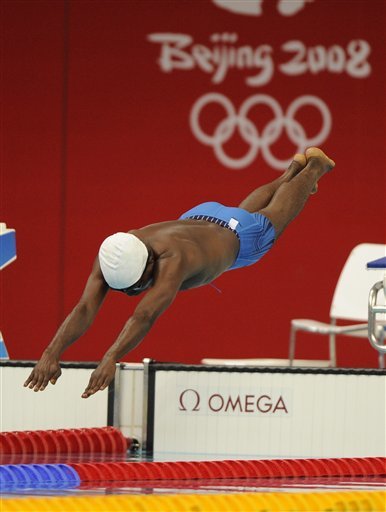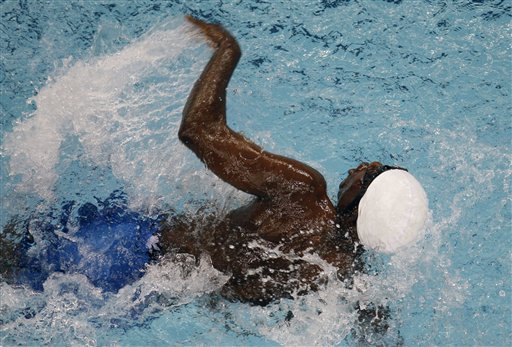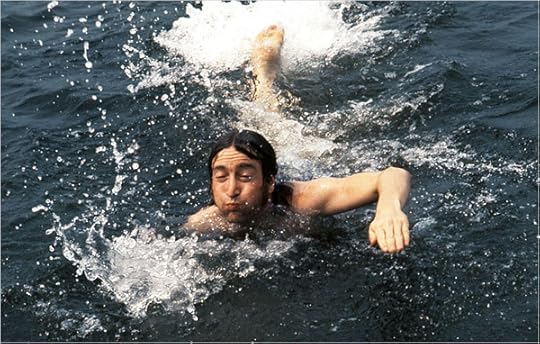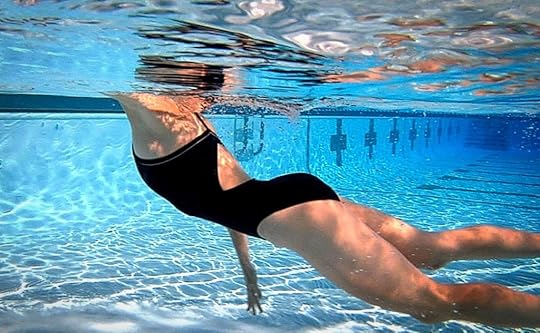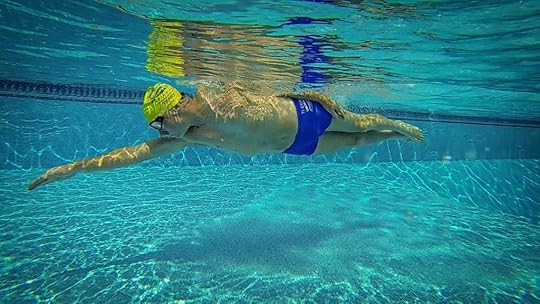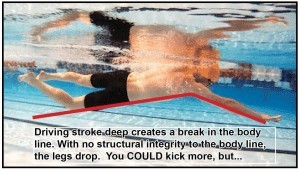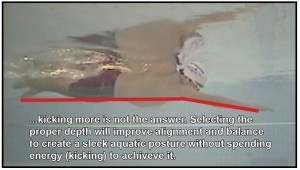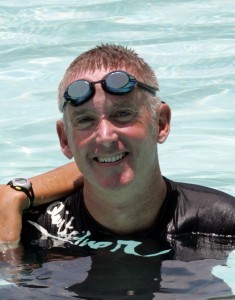Terry Laughlin's Blog
September 19, 2024
Guest Post- TI Coach Werner Goldbaum
Water’s Invitation
WERNER GOLDBAUM
A surprising situationSome of you, perhaps many of you, will know the opportunity that sometimes arises: You didn’t plan, you finished your three or four days training in the week, you’re satisfied or not so satisfied and suddenly there pops up the possibility to swim once more this week. A small lake on the way, an unknown pool and half an hour or an hour to jump in will fit into your schedule. And I think you’ll know the (good) thoughts similar to: Oh, I should swim my best day’s program a second time… Or: Oh, I should swim again the day’s plan that didn’t turn out as wished… Or: Great, some more minutes in the water! I’ll jump in without any plan, just for enjoyment. (I tout it as swimming for myself)… If this is your reaction to the opportunity for another swim, then you may not need the following advice, although perhaps it will catch your interest anyway.
On the other hand, if your thoughts in the above situation tilt to the other direction as: Oh, half an hour is not worth the effort to change… Or: Oh, this week satisfied my swimming so much, I won’t disturb it… Or: Oh, all days went not as hoped, don’t like another swim like that… (Think most of the readers are Total Immersion swimmers, so my first suggestion to these thoughts is: Think again, what can you learn from such a bad week.) If you try to find any reasons not to swim, then you definitely should read on, take a piece of paper and a pencil, write down some keywords and place them at the console of your car or into the side pocket of your swim bag.
Water’s invitation for a gameSee the above possibility as water is inviting you for a kind game. If you’re swimming for some time (at least in the Total Immersion-way) you might have found out, that the water is always playing with you. Water is always ready for, it’s always kind and you’ll never find anywhere a partner who is playing as fair as the water. The water will never cheat. In any way you can trust it without doubting, but every moment it has an overwhelming awareness, you don’t have any chance to cheat it, so don’t even try. If you do so, you’ll lose the game. If you take it as exciting experience this pooltime will become a felt satisfying enjoyment. As playing with kids sometimes, no stated rules no pointed sense, doing this, doing that together and you and your kids will turn or stay in good mood.
Let me point out some ideas. You’ll find the direction and will be much more creative than I’ve been. The following are not the typical and proven useful Total Immersion-FocalPoints, remember these are more a game with the water than pin points for anything else. Most of them are not measurable in their own in any way, they are not controllable or even visible by coaches. Here you’re your own coach (in the best Total Immersion-way) and have to trust your awareness, your feelings and, most important, your enjoyment of the game.
An easy part of the gameGo on, swim for yourself! Ok, you always do, or should at least; but in this situation don’t strive for a special thing. Forget the Tempo-Trainer, forget or don’t mind your next competition or challenge, forget your StrokesPerLength. This may be too difficult for a Total Immersion-swimmer, if addicted to counting strokes unconsciously; but take them just as numbers. You’re playing a game of maximizing your enjoyment in the water. Try to look at your stroke, posture, glide, feelings… from outside. Do not judge anything. Listen to your feelings and let them suggest the next FocalPoint directing to more enjoyment for the next length or, in Open Water, for the next 20-50 strokes. Then decide by feeling the next FocalPoint… Don’t forget your limited time.
Nano-Focal PointsThe following FocalPoints are oriented toward the Total Immersion-Balance-
Streamline-Propulison-Pyramid, but they are not meant as the typical Total Immersion-FocalPoints to work on for several lengths or hours and hours. They are meant as ways to play. If one seems to become boring or too sophisticated (you can call too brain damaged) try the next one…
And keep in mind, you are playing a game of joy together with the water not a gradually Total Immersion-program for immediate stroke-improvement.
Little things in BalanceFor all your tries with the following nano-FocalPoints do, what Total Immersion is sometimes accused of. Swim as slowly as possible. Every stroke should be on the edge of disturbed balance. Remember you’re not Total Immersion-swimming you’re going to play in a Total Immersion-oriented way.
Cuddle deeper into the PillowSwim extremely slowly and point your focus to your (hopefully) still relaxed neck and head. Weightless head is what you should feel when beginning with this game…Then start slowly lifting your head and looking up from bottom more and more forward. Aside from realizing the tension starting in your neck, have an even closer look what happens with your spine. Where is the point when it starts to bend (more) to hollow-back? When looking slowly(!) down again, at which point do you feel a really straight spine? Do you feel the easing tension? From which point? What happens with your hips when you start to look forward and down again? What with your legs? Give yourself an answer to probably the most common question from Total Immersion-coaches: How did it feel?
For the next strokes cuddle deeper into the pillow the water offers. From relaxed starting position start with looking more straight down to more and more back into a real nodding tension and then relax (both slowly!) to your relaxed starting position. This will seem more unusual to you, because most of us tend to look a bit more forward than straight down, but ask the same questions: What shape is the spine? Where, upper, lower or all over does it start to bend? Did you start with straight spine in your usual swim-starting-position? What did your hips and legs do meanwhile?
Deeper Breath
You know the belief of the benefits of belly-breathing? Do you agree? Is belly-breathing your favorite breathing-technique? Well, your answer may be similar to mine: Yes, hmmmm, most often…sometimes, not always FocalPoint… But now, you’re going to play with the water. So let’s play a bit around with air-chest-belly. Start with Total Immersion’s Torpedo-drill and try to find out: How does your push off and float work when inhaled deep in your normal way? What changes, when inhaled totally into your chest? What when inhaled totally into your belly? What when you took the deepest possible inhale, started deep in your belly and continued up to a totally inflated chest? (Think you know what I mean, physiologically you can let air into your lungs only, not into belly or chest.) What happens, if you relax from that tensed inhalation? What if you go on further and press out some more air?
Do the same with full strokes, but so slowly that you’ll feel the differences.
Same questions.
Did you find a special kind or a special point of your in- or exhalation where the flow feels best or easiest? Is it worth to change some tiny things like more air up or down or more or less tension that might pay off as better balance, glide or streamline?
By the way: When going to sleep and focusing in some very deep breathing up from belly to chest as described above, you’ll fall asleep faster than usual. Try it!
Balance like S HINJI ?
In his 9-Strokes-video TOTAL IMMERSION-Mastercoach SHINJI TAKEUCHI demonstrates (as usual for him) a balance as if he could to stop the recovery movement in nearly every moment. Though I think, most of us will not be able to show perfection as SHINJI does, that doesn’t mean, we should not work on it.
So we are playing around with the water and should give it a few tries… with some questions to ourself: How slow can I stroke without losing balance control? At which point can I stop my recovery motion without losing balance control? How long can I hold it? At what point of movement is it impossible to stop at least for a millisecond? What do I have to do to find the balanced millisecond-stop? What happens with my body, while I’m stopping the recovery movement (all movements)? Am I able to stop every tiny movement at any/some/one special recovery moment? How long will that stop last? What breaks down? At what point is an issue of left-right-balance? Does it change at any point to an issue of back-forward-balance?
The MORSE-FocalPointEvery Total Immersion-swimmer knows the FocalPoint of dragging the fingertips behind the elbow with gracing the surface. Well, we’re playing around so try to refine it to what I call the MORSE-FocalPoint. Don’t grace the surface, just grace the tips of the waves with your fingertips. It should feel like Morse-code for transmitting telegrams in former times: da-di-di or – ·· for TI. Just for fun. Won’t turn out as TOTAL IMMERSION every time. But some MORSE-Funkers are fairly fast, so try it with some fast strokes. Not necessary to translate into words what the water lets you know, just feel and enjoy.
The dangling armOur recovery, led by the elbow with relaxed lower arm and hands/fingertips behind does reach a point (individually different) where the relaxed arm/hand has to go in front of the elbow, still relaxed. Did you ever play around with that point? A little bit backwards and the arm has to dangle further to front. A bit further to front, but can you hold the lower arm still relaxed? Is your draping arm completing your relaxed natural recovery, or do you have to make some effort to the fingers to the right slit?
Try that slowly to get your awareness to the critical points. Then accelerate your stroke a bit and be aware at what rate the elbow gives up the leadership role and your recovery become too much like Dino’s claw (greetings to Mastercoach STUART). Is there a special StrokeRate and elbow’s pendulum point where it feels best or most relaxed?
Little things in StreamlineOnce upon a time in the TOTAL IMMERSION-Forum the busy writing, kind and creative (non-TOTAL IMMERSION)-swimcoach CHARLES COUTURIER wrote (analogous): Everyone of us can nearly feel how the world-elite feels while swimming… in the few seconds of our push-off from the wall. Thought long about it and am now sure, he’s totally wrong. We can’t. Confirmed by watching a young lady in the pool some weeks ago. She was wearing a swim cap with GER (team Germany). Must be an elite swimmer in the effortless way she overtook everyone else and the fast way she left the pool without any chance to talk with her. What I admired much more than her (in many parts TOTAL IMMERSION-like) swimming was her nearly powerless, slow but faaaaar (nearly 10m) push off, seemed without any deceleration but overtaking everyone aside. And no, I could not notice any kind of dolphin move. Streamlining at its very best, nearly unbelievable form. Not sure if the mortals of us may reach such perfection, but we can go some steps in that direction. With the TOTAL IMMERSION-streamline-drills and with our game today…
Fingertips-PressureDid you ever put your attention to the pressure on your fingertips? Starting while cutting the slit into the water spear-start? Yes, nevertheless if you swim slow or fast, the very front fingertips should feel the maximum pressure. It’s impossible to avoid that pressure, your spear is the fastest movement forward and then your fingertips are the very front of your hull, simply they must separate the water molecules, felt as pressure. It will be a good task to feel that and find a trace to feel it the whole way from slit to extended front. Nobody will be able to tell you exactly how the trace of your fingertips has to look like, it’s your own game (together with water) to find out and decide to take it or vary a bit more. The next FocalPoint may help.
Silk is too roughDid your coach ever tell you, your spear should feel like slipping into a silk sleeve? He was right, but now we’re playing around and should go a step further, it should feel like slipping into an air sleeve, even better into nothing. When you feel the pressure of your spearing fingertips (see above) behind them a cone of more pressure (outside) and less pressure inside arises. If you find a spear-movement from fingertips to upper arm where all parts of the arm are inside this cone you don’t feel anything. First step is feeling same pressure all around the lower arm, the upper arm, the whole arm; then you got the silk sleeve. The difficult ideal will be feeling only your fingertips and your slipping into a sleeve of nothing. Start with attention to your hand, your wrist and lower arm, your upper arm and shoulder. Not all will come together at once.
Play around with point of the slit forward-behind, left-right; the entranceangle of your fingers, hand, arm; how to support your spear with body rotation connected to your upper arm and more or less screw-like dive in.
Pressure on the top of your headThe pressure cone generated by your fingertips (see above) will mostly be too pointed to get your whole body in. The top of your head and your shoulder will have to expand it a little bit. Here the head has to separate the molecules and take the resulting, mostly unavoidable pressure. But have in mind only the top of your head. Observe if you feel any soft streaming of water on the back of your head or your face, it’s a kind hint from the water, you’re looking too much forward or too much backward or your turn to air is not best aligned. Try to reduce this seductive feeling or even avoid it. You’ll feel more relaxed and calmer.
Hidden KickYes we all know, our legs should stay inside our hull-formed tube; I do like the pressure-cone-picture much. But how do we feel our legs? If we don’t feel any kind of streaming on our legs we can be nearly sure they’re inside our tube/cone. But aren’t they too passive to support our stroke? Try to find out the boundaries with the following questions: How much can I relax my knees for the following kick, but without feeling flows around? How much (better how less) can I swing my kick starting from the hips without flow on my thighs? Am I able to do some flip-like kick with feet mainly, with just the toes will feel the water? How can my kick support rotation while feeling only tiny pressure distributed equal over whole legs front? What tiny modifications do I have to make (am I able to make) to go a directed step to that feelings?
Some more Points of AwarenessWhen swimming, do you feel that kind of silk-soft flow around your body? Can you find some tiny changes to reduce even that more to nothing? Single body parts are feeling more intense streaming – possible to take them into the cone? Like tucking the belly in a bit, looking more down to help straightening the spine and reduce the flow on your chest. Different felt flow on your chest and your belly or hips might show, we unlocked our hips related to shoulder or vice versa. More felt flow on one side often shows an unnecessary left-right bent spine, often breaking the alignment to go for air. Tiny adjustments possible? If not, where is the hurdle?
Little things in PropulsionIt’s hard to separate the three Balance-Streamline-Propulsion-steps in this, too many interdependencies. But let’s take some tiny things I’ll put to the propulsion-step.
Drift to CatchIn his new course for advanced TOTAL IMMERSION-Freestyle SHINJI has some hints how we can use the building phase of the catch to get some (tiny) propulsion. Here we’re playing with the water in more or less slow motion that should help us to the draw attention to some feeling-points. The movement from totally stretched spear (TERRY wrote in his Ultraefficient Freestyle, a nanosecond would be far long enough) to the optimal formed catch sometimes doesn’t get enough attention. I recommend to strive for a totally forceless movement. If you let your arm and hand drift and form from very front to the catch form as if hugging a large Pilates ball, the elbow still on its place. You should not spend the tiniest force or effort. Let your hand and lower arm flow down and drift to the catch. The slower you swim the more attentiveness you can put to your hand and arm. Your velocity of glide defines the velocity to build the catch. Which tiny changes can avoid any force up-down (or this time unusually, left-right)? Are you building the catch slowly enough to avoid the start of bobbing? Did your hand hold the path on its (thought) straight rail? Is your speared arm still patient enough, becomes it too patient? Is your catch built ready and still in front, when the other arm is entering the slit? Are you still in stable front-back-balance when your catch has been formed?
Zero PressureYes, slowly OK, but we should get a bit forward! Let the water invite you to test. When you found the today’s optimum for the above forceless catch, go on with your stroke, but don’t put any conscious force to your lower stroking arm, just hold the catch on its place and rotate and spear the other arm. No force means, you should not hold the catch-arms stiff in front. That is force. Hold him on his place and rotate… and experience the miracle that you moved forward without any felt driving force, seems just by rotation. (There are some forces driving you forward. Won’t discuss them here.) More, if you count your strokes this time for a lap, you’ll find only three to five more than normally.
This has been exactly TERRY’s experiences when he swam with broken shoulder. He lets us participate even with healthy shoulders, described in Ultraefficient Freestyle.
Tiny PressureIf you go on and put a little pressure into your stroke. Your arm should have built its most optimal catch before, when you start with some tiny force backwards… Stay aware and answer the following questions: Do you feel a constant pressure at your whole arm from hand to upper arm? What can you change to get nearer to this constant feeling? Do you feel the pressure on your arm only on the side showing backward? Do you move your arm as stable entity, not elbow first, hand last? How can you vary the pressure just by connecting the way back (body forward) more or less to your body rotation? Might your kick in various ways change your effort to force? All these are tiniest adjustments. Watching and separating them will be easier the slower you swim, but still balanced. And you will have to decide what seems worthy to take with you from this game.
Higher PressureTERRY never pressed hard. But what TERRY called hard may be another thing for us. Some suggestions to find out your individual optimal force for pressure. (Look at his description in Lection two of his 2.0 Freestyle Mastery.)
Start with none and tiny pressure as above. Watch your arm when putting in more force to move. The faster your arm moves the more swirls will build around your arm. Feel them growing with more pressure and them sneaking around your arm to the front. On your relaxed fingers the whirls are not so bad, they even build a larger surface like a paddle. This doesn’t work if you spread your fingers with tension as far as possible or press them together. Test it. When starts your hand wobbling around, when you press the fingers together? When do you feel the water flowing between your fingers and the whirls going around? What is the easiest hand with relaxed fingers getting the best grip?
On our arm it’s more difficult. The sneaking whirls from back to front are not unique on every area of the arm. But do you feel where on your arm the whirls first go to front and start to hold that part more back than let you move it in the direction backward? (In my own case it’s always my wrist.) And now it becomes really tricky. You’re the only one who can decide: Put in more force to pressure? Does it really pay off in velocity forward? What pressure is the right decision for this swim just now? Well, for our game with the water I think: Stay relaxed and when the whirls are starting for any part of the hand/arm to sneak more forward than half the wrist we should slow down and take our attention to some tiny variations of just this or other parts. By the way: Time enough for a shower to go back to your planned day?
TERRY’s QuestionWell, I’m finishing this post on TERRY’s birthday. Some very thankful and sad thoughts not only on this day. And I try to imagine what he would say: Are we better swimmers when we jump out of pool or lake after such minutes? My answer would be: TERRY, we spent some time in water, played and moved around in joyful way, became aware -or not- of this and that. If conscious or not, we improved our feeling for the water and deepened our friendship with the water. We are better swimmers. And TERRY might answer — in my imagination: Yes, I agree. I Have some ideas how to structure that in some way and several million ideas how we should expand that…
TERRY, thank you so much!!!
Last but not least thank you very much to TI-swimmer DANIEL BAKER, who transformed my poor English language into readable form.
The post Guest Post- TI Coach Werner Goldbaum appeared first on Total Immersion.
April 12, 2024
Total Immersion Newsletter 11 April, 2024
The ancient wisdom “Know Thyself,” inscribed on the Temple of Apollo, has inspired countless interpretations over the ages—from understanding our abilities and limits to exploring our deepest motivations and aspirations. How often do you pause to reflect on your swimming technique, the nuances of your strokes, and where your focus lies as you glide through the water?
Embarking on a journey to enhance your swimming isn’t just about adhering to a schedule or revisiting old habits. While these practices can provide comfort and predictability, they might not lead to significant breakthroughs.
Imagine approaching your swim sessions with an open mind, eager to experiment with new techniques, to deepen your understanding of your routines, and to swim with intentional focus and curiosity. This mindset transforms swimming into a mindful and exploratory activity, full of potential for discovery and improvement.
As we reignite the Total Immersion newsletter, we’re calling on swimmers who embody Terry Laughlin’s spirit and approach to coaching—those open to reassessing their techniques, curious about innovative ways to enhance their flow, speed, or comfort in the water. We value swimmers who critically analyze their performance, seek out areas for improvement, and are excited about the prospect of innovation, regardless of their experience level.
This week, we invite you to take a closer look at your swimming practices:
Monitor your stroke count at a sustainable pace. What’s your count per length, and how fast are you going?Assess your default breathing pattern and effort level, including your kick tempo.Experiment with changes and observe:
Alternate your breathing side.Adjust your breathing pattern or use a front-mounted snorkel for different perspectives.Modify other variables, like gear or effort level, focusing on one main aspect of your stroke.Our goal is to “Ti-ify” your swimming experience—integrate metrics like time, stroke count, and effort level into your routine. Learn by observing and improving through focused practice and embracing mistakes. This initial step of gathering data about your current swimming practices sets the stage for more sophisticated self-coaching tools we’ll introduce in our next newsletter.
**For seasoned swimmers, we recommend collecting data after warming up to ensure accuracy.
Written by Dave Cameron
Director of Coaching
Total Immersion Swimming, Inc.
We’re excited about our upcoming website redesign, which will help you explore various coaching services tailored to your learning preferences.
TI Private or Semi-Private Lessons: Tailored sessions ranging from 30-60 minutes in different settings. These lessons focus on aligning the coach’s expertise with your goals, ensuring clear objectives for future practice sessions. Learn more and find a coach here. TI Group Practices: These sessions mix technical instruction with informed training, offering a variety of strokes, efforts, and distances, all within a team environment. Discover more about group practices here. TI Workshops: Ideal for those looking for an immersive experience. Our workshops include multiple filming sessions, both above and underwater, with detailed feedback from senior Total Immersion coaches. Find workshop details here. TI Online Workshop: Our latest initiative offers an online workshop experience, drawing on 45 years of expertise. This program introduces new concepts for novices and serves as a refresher for veteran swimmers. Join the online workshop here.Dive into a journey of self-discovery and improvement with Total Immersion. Let’s redefine what swimming means to you.
Sincerely,
Alice A. Laughlin
CEO
Total Immersion Swimming, Inc.
The post Total Immersion Newsletter 11 April, 2024 appeared first on Total Immersion.
May 22, 2020
[Guest Post] Naji Ali, Marathon Swimmer and TI Coach

Naji Ali is a Level 1 Total Immersion Coach, and aspiring marathon swimmer based in San Francisco, CA, where he lives with his wife, Chrissy, and their cat, Mrs. Chippy. He works as an essential worker feeding the homeless and marginalized poor.
As I write this we are in day 60 of the “stay in place” order that was issued since the pandemic began here in California. For a week prior to this order, I was in Kona, Hawaii, swimming with pods of dolphins, meeting amazing people, and teaching TI technique at an open water swim camp.
What a different world we’re living in now.
Every day brings new challenges, hardships, and fears. People are dying, others lost their jobs, health care workers are doing a job without proper personal protective equipment (PPE). Businesses are shuttered, schools are closed, and, of course, pools and beaches are off limits.
But in the midst of all this doom and gloom, I have seen truly selfless acts of compassion and generosity. I’ve seen friends post videos making PPE’s for healthcare workers; others buying groceries for elderly neighborhoods whom they never spoke to and having them delivered to their home; incredible musicians serenading the entire world via Zoom.
But, despite how in many ways this pandemic has brought out the best in us, I have a confession to make; I miss swimming really bad. I really miss open water swimming. It was always my release when I was having a difficult time, but now, that’s not possible.
I get it. I do. Social distancing is essential to “flattening the curve” of this virus. I get that wearing a mask and only going out to get food helps stop this contagion from moving further, but goodness I miss the salty water.
I miss the exhilarating feeling of stepping into 55F wetness with only my swimsuit, goggles, and earplugs, and swimming amongst the seals and jellies; swimming against, and with the current; Enjoying the swell and chop; Being mindful of my lead arm staying put till the fingertips of my recovery arm re-enter the water.
I really miss swimming.
But even though I can’t get to the water at the moment, I have a huge community of TI folk that I can connect with on our FB page, and a weekly coach’s zoom meeting. I get too meet coaches from all over the world that I had only heard about, or saw swim in YouTube videos. I still have the opportunity to offer up advice on someone’s practice when they post video on the TI FB page, and celebrate with them when they experience that “aha” moment in cyber space.
Is it the same as being in the pool, or open water and physically assisting them? No, of course not! But just being able to connect is so vital.
One of the reasons why I wanted to be a TI coach was seeing how the ones who taught me TI, invested so much time into making me the best swimmer I could possibly be. Back before we had a FB page, we had the forum on the TI website, I would constantly go on the forum and ask questions about technique. It never took long to get a response. Often coaches would send me a personal note to email them directly, and send along a video, if I had it, so they could offer up suggestions for improvement.
That for me is where I see the correlation between the generosity of folks helping their neighbors and complete strangers during this pandemic, and TI. You see TI is not just about technique. It’s about community and the willingness to offer up something valuable to others simply because they want to help them get better.
That, too me, is one of the many reasons that I love TI, and I love being a TI coach, but I still miss swimming in the open water.
The post [Guest Post] Naji Ali, Marathon Swimmer and TI Coach appeared first on Total Immersion.
March 21, 2020
Join us Today LIVE at 12:00 EST!
Announcement from the TI Swim Studio in New Paltz NY: we will be streaming LIVE on the Total Immersion Instagram account at 12 noon EST (9am California, 5pm UK). This will be the first of many new content streams from TI coaches to stay connected with all of you around the world. Today’s stream hosted by Terry’s daughter and longtime TI Coach Fiona Laughlin with an intro to the Swim Studio, some demos in the Endless Pool, dry land recommendations that you can do right now at home, as well as a Q&A. Get the Instagram app if you don’t already have it and follow @totalimmersion. Be well and stay safe everyone!
The post Join us Today LIVE at 12:00 EST! appeared first on Total Immersion.
March 13, 2020
Swimming Principle #1: Always Save Energy Before You Spend It
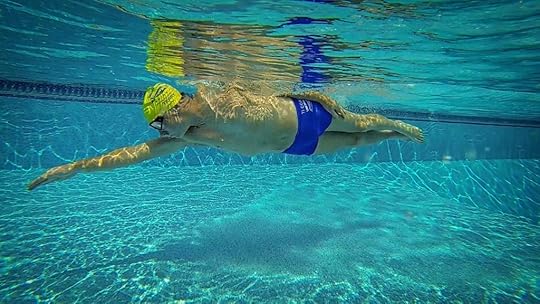
This post was previously published by Terry Laughlin on Aug. 7, 2015.
At the Beijing Olympics in 2008, Stany Kempompo Ngangola gained a measure of fame for swimming the 100-meter freestyle.
Not for his speed, but simply for surviving.
Stany was among a small group of athletes—mostly from small underdeveloped nations–who are invited to the Olympics in hopes that the exposure will encourage sports development in their homeland. These athletes are exempted from Olympic qualifying times.
Stany was selected for this honor a year in advance and given assistance with preparation by coaches from advanced swimming nations. Unfortunately the training he was given focused mostly on conditioning with little attention to technique.
Swimming in the first heat, Stany relied on youth and strength to get through his first 50-meter length, but hadn’t gone far on the second length before the commentators began to express concern—shared by everyone watching–about whether he could make it safely to the far wall.
Here’s a picture of Stany—looking very athletic—in the air.
And here is Stany in the water, struggling to complete 100 meters.
What’s remarkable about Stany is how utterly unremarkable he is. I estimate that 95 percent of the millions who watched his struggles on TV would fare no better if put in that position themselves. You see, swimming, as an aquatic skill, is an ‘alien’ activity for land-adapted humans. Do you recognize the swimmer below?
John Lennon… Human Swimmer!
Energy Wasting Machines
That’s why we say that it’s critical to recognize that—as inheritors of millions of years of adapting to life on terra firma—it is simply human nature to be an ‘energy-wasting machine’ in the water.
This was confirmed by a study done by DARPA in 2005 while designing a swim foil for the Navy Seals. They found that dolphins convert 80 percent of energy into forward motion. The humans they studied (lap and fitness swimmers—people who thought they swam ‘okay’) were only 3 percent energy efficient.
This bring us to Swimming Principle #1: Always focus on saving energy before increasing fitness.
To apply this principle, do the following:
• When developing technique, master Vessel-Shaping skills (Balance, Core Stability, Alignment, and Streamlining, before propulsion skills (pulling and kicking.) Vessel-Shaping skills take little energy to perform and provide significant payback in energy savings. Propulsion skills require much more energy and power to perform.
• Propulsion A: When you focus on your pull and kick, pay attention first to how you use the arms and legs to minimize drag, before focusing on how you apply pressure to the water.
• Job One for your arms is to lengthen your bodyline, since that reduces wave drag.
• Job One for your legs is to draft behind your upper body—not to churn the water into a froth.
• Propulsion B: Strive to replace forces generated by your muscles with ‘available’ forces from nature—gravity and buoyancy.
• Swim farther by learning to swim a shorter distance almost effortlessly—rather than pushing to add another length.
• Swim faster by learning to swim at your current speed as easily as possible. Faster times will then come as a matter of course.
• Indeed, for any swimming set, task, or challenge, always start out with the intention to find the easiest possible way to complete it—rather than testing your ability to push through fatigue or discomfort.
Learn energy-saving techniques with our downloadable Ultra-Efficient Freestyle Self-Coaching Toolkit. The drills and skills are illustrated in 15 short videos. Guidance on how to learn and practice each drill effectively is provided in the companion Workbook.
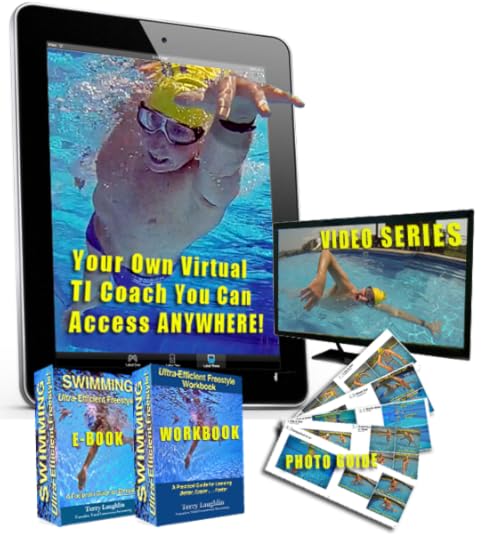
The post Swimming Principle #1: Always Save Energy Before You Spend It appeared first on Total Immersion.
March 6, 2020
Sharpen Your Breathing Skills: Open– Or Close– Your Eyes To Heighten Awareness
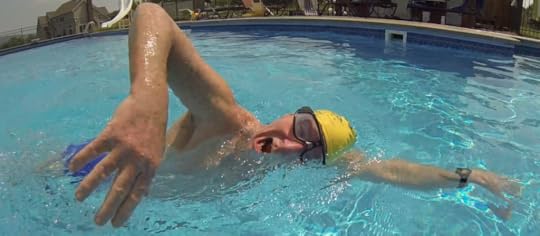
This post was previously published by Terry Laughlin on Apr. 12, 2011. The forum post mentioned is archived.
Few swimmers really pay attention. Opening – or closing – your eyes can change everything.
John shared an exciting discovery about breathing on the TI Discussion Forum:
I’m a bit reluctant to admit it took me a year to come to this insight, but perhaps it will help others. I’ve always struggled to find the right head position for breathing. Sometimes I feel I need to nearly submerge my head to feel balanced, but in that position I feel I can’t get air. I had an ‘aha’ moment last week, when I finally noticed that I close my eyes while breathing. I began to consciously keep my eyes focused through the breath and it has made a world of difference. Now I can see precisely how far to rotate, when to inhale and when to stop. With my eyes closed, I would turn my head too far, lose balance and then need to recover.
Now, as I rotate toward air, I see the tint of the water change, watch one goggle clear the surface, begin inhaling and close my mouth just as the water closes over it. Suddenly I feel as if I have far more time to breathe and I stay better aligned and balanced. With eyes closed, I didn’t know what I was missing. Too bad it took me a year to figure out. Doh!
John, congratulations, on your invaluable insight – which came over 30 years quicker than it did to me! I can precisely recall the day I had a similar discovery. I was swimming at Lake Minnewaska on Labor Day weekend around 2003. It was chilly – about 54 degrees – and raining steadily. My friend Dave Barra and I were the only two people swimming.
After we’d been swimming about 10 minutes, looking for diversion, I began “scanning” with my eyes as I rotated to breathe. First I noticed that the underside of the surface was dimpled by the rain and found that almost mesmerizing. Then I kept my gaze keen as my eyes and mouth broke the surface. Like you, I immediately realized this helped me sharpen the timing of the breath and make small adjustments to head position. That has stayed with me ever since.
While your insight will be of value to many, I think you also make a larger point — The Value of Being Observant. Paying attention, and consequently noticing things that usually escape your attention is relatively rare among swimmers. This is a result of the common focus on yardage totals, repeat times, intervals, etc. Tuning out to get through it also results when workouts are tedious or lack a clear purpose beyond “getting the yards in.” The fact that it took me 30 years to notice what you noticed after one year is evidence of how pervasive inattention can be.
Be Observant is just another way of saying Swim Mindfully.
And here’s the flip side to your discovery of the value of keeping your eyes open. Have you ever noticed yourself closing your eyes when trying to intensify your focus, usually on a subtle or elusive aspect of technique?
After I began swimming more mindfully, I noticed that during moments of especially keen focus I would instinctively close my eyes. It’s well known that people who lose their sight become far more attuned to sound and feel. For the rest of us, taking away visual input has the effect of making your sense of feel a lot keener. In water — which is literally a sea of sensation — anything that sharpens kinesthetic awareness is invaluable. You can experiment with brief periods of swimming with your eyes closed (when it’s safe to do so) to heighten your sensitivity to sensory input and increase your awareness of the subtleties in your stroke, including how you breathe.
In a previous post on breathing, I also wrote that many people have found it much easier to breathe when they realized they could both inhale and exhale just enough air, and didn’t need to either fill or empty their lungs. The point is really to notice things you may have ignored before.
To learn more in-depth detail about the breathing mechanics of efficient swimming, check out our video “O2 in H2O: A Self Help Course on Breathing in Swimming”– available as a digital download or on dvd.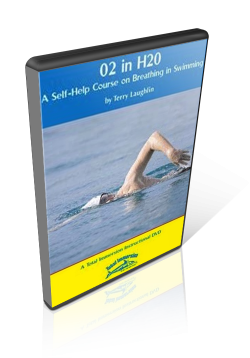 Nothing is more essential to a swimmer than air. Yet few swimmers truly understand how to breathe efficiently… not just to get air, but to integrate breathing seamlessly with the stroke. Breathing is sometimes viewed as a liability or inconvenience, but when you do it right, breathing can actually make your stroke better. This video shows you how, using water bowl exercises, shallow water exercises, skills in drills, and whole stroke breathing skills. Detailed studies with focal points for practice cover these three major strokes: Freestyle, Breaststroke, and Butterfly.
Nothing is more essential to a swimmer than air. Yet few swimmers truly understand how to breathe efficiently… not just to get air, but to integrate breathing seamlessly with the stroke. Breathing is sometimes viewed as a liability or inconvenience, but when you do it right, breathing can actually make your stroke better. This video shows you how, using water bowl exercises, shallow water exercises, skills in drills, and whole stroke breathing skills. Detailed studies with focal points for practice cover these three major strokes: Freestyle, Breaststroke, and Butterfly.
The post Sharpen Your Breathing Skills: Open– Or Close– Your Eyes To Heighten Awareness appeared first on Total Immersion.
February 28, 2020
Which Kick Is Best for YOU… 2-Beat or 6-Beat?
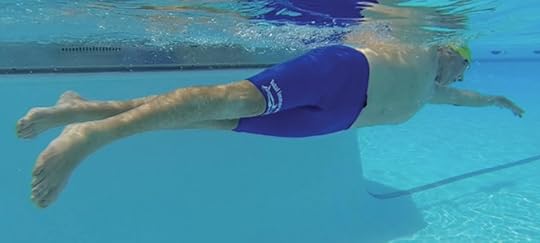
The following guest post by TI Master Coach Gary Fahey was originally published on Mar. 16, 2014.
A blog post discussing kick strategies landed in my inbox a couple of weeks ago, much of it advocating a six-beat kick (6BK) for all but the most skilled of swimmers.
While I disagree with this premise and the example presented through the .gif in that blog post, I agree with the writer that long distance and open water swimmers should use their legs primarily for stability rather than propulsion. The energy cost of propulsive kicking is simply unsustainable.
Total Immersion advocates for increasing speed through smarter choices rather than greater effort. Among the most fundamental of those choices is to improve core stabilization—which is a critical foundation for a mastering 2-Beat Kick (2BK) skill.
One adjustment, I suggest to my swimmers is to experiment with the depth of the extended arm. When they do, they learn that a very shallow extension causes the legs to sink. But so does reaching too deep.
Reaching too deep breaks the body line where arm and torso connect. Picture a see-saw plank with a collapsible hinge: applying pressure at one end would not exert any influence at the other end. But when you open that hinge to establish a single, structurally sound plank, then adjustments at one end affect what happens at the other.
Sinking legs can be counter balanced by finding the optimal angle or depth at which to ‘spear’ your arm forward. Spearing 12 to 15 inches below the surface tends to shape the body into a balanced, stable and sleek line. Adding a moderate forward stretch (eliminating laxity) will bring tone to the core, strengthening the connection between front and rear.
In the blog post, the coach suggested the swimmer had improperly matched a 2-beat kick to his overall mechanics, which explains the dropped legs. His suggested fix was a 6BK.
This misdiagnoses the problem and offers an energy-wasting solution.
My view: By extending too deep, the swimmer breaks the connection from extended hand in front through legs at the rear. Like the plank with a broken-hinge, balancing forces in front cannot act upon the rear.
If he ‘speared’ a few inches shallower (which would also direct more energy forward) he would increase structural integrity in his aquatic posture and bring his legs into balance.
Once he corrects his balance problem, the 2BK would not only be an appropriate match for his swimming style, he could likely scale back on his current degree of knee bend and further reduce drag. More stability = lower energy cost.
Compare the red lines in the still frame image at top (taken from the other writer’s post) to the image from TI Coach Shinji Takeuchi’s top-ranked YouTube video. Shinji extends to a shallower end point, which draws his body into a sleek line. His legs draft cleanly behind him and the energy cost of his 2BK approaches zero.
This illustrates a simple solution to sinking legs—one which results in kicking less, not more.
Besides this misdiagnosis, this blog post also drew a distinction between two styles of 2BK. TI advocates the Shinji 2-beat kick which connects the kick downbeat to the spearing arm.
The other writer advocates a style used by very high tempo swimmers like Brooke Bennett in this clip in which the downbeat of the kick connects to the catch phase of the stroke.
The high tempo 2BK style is an extremely challenging configuration that can be done successfully by high-mileage, experienced swimmers, but is too exhausting and difficult for the vast majority.
The blog writer rejects the efficacy of the TI 2BK, which he calls a “kick-start” that compensates for what he calls “over-gliding.” I think the “kick-start” 2-beat kick is just fine for most purposes, certainly at tempos of 1 stroke per second and up.
There are legitimate pros and cons to selecting any kicking pattern, and not room here to discuss them all. My primary goal is to show improvement-minded swimmers that they can opt for efficiency rather than effort.
If you want a more effective kick, you can achieve it through balance and stability—a choice that conserves energy rather than wastes it. Most swimmers already do far too much of the latter.
Editorial Note– For a step-by-step breakdown of the mechanics of the 2-beat kick, see this related post:
Gary Fahey has been a Total Immersion Certified Coach since 1998. He teaches swimming full time through his Fort Lauderdale-based company, Stroke Doctor Swimming. In 25 years coaching competitive swimmers, he has qualified athletes up to the US Olympic Trials level. Contact Gary at gary@strokedocswim.com
The post Which Kick Is Best for YOU… 2-Beat or 6-Beat? appeared first on Total Immersion.
February 21, 2020
Your First TI Lesson Is Learning To Be “Weightless” in the Water
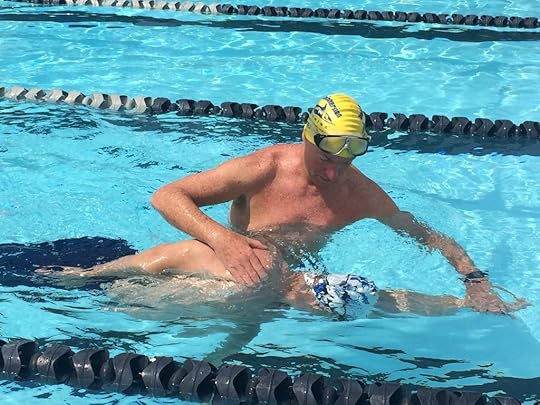
A version of this article by Terry Laughlin was previously published on ivillage.com in Dec. 2011.
Total Immersion teaches swimming as a practice—in the spirit of yoga and Tai Chi– rather than a workout. The first principle of swimming as a practice is to let go of the usual goal of “Getting to the Other End.” Your new goal is to Be Aware of Every Stroke. Another word for mindful swimming is intentional swimming. It works best when you target a single, highly specific element in your stroke. The foundation skill of effortless and enjoyable swimming is Balance–or feeling “weightless” in the water. This series of three focal points are designed to improve Balance in the crawl stroke.
Hang Your Head
While stroking “hang” your head– release its weight –until it feels weightless. Neither hold it up, nor press it down; just let it go. When you release it, concentrate on feeling that it’s cushioned by the water. Finally, notice if you feel a new relaxation— and maybe freedom of movement —in neck and shoulders.
Float Your Arm Forward . . . Slowly
Next focus intently on the extending arm. Feel the same “cushion” supporting your arm as you extend. Watch for— and eliminate –bubbles in your stroke (looking down, not forward.) Finally, explore how slowly you can float your arm forward . . . and try to extend slightly farther than usual.
Calm Your Legs
Your weightless upper body should help your lower body feel lighter than usual. Take advantage by “calming” and relaxing your legs. Instead of churning them busily and noisily, let them “draft behind” your upper body, in a slipstream. Strive for the easiest, quietest, and most streamlined movement possible.
Practice Tips:
1.) Before practicing the three focal points, swim a few lengths as you usually do. Count your strokes and rate your effort from 1 (Effortless) to 5 (Exhausting). Repeat this exercise after each focal point to measure how they affect your ease and efficiency.
2.) Practice each focal point by doing a series of learning/familiarizing repeats followed by a series of practicing/memorizing repeats.
Learning/Familiarizing Swim a series of short (4 to 6 strokes, or 10 yards or less) repeats. Push off the wall, swim a short distance. Catch your breath and return to where you started. These repeats serve two purposes: (i) to break the habit of feeling obliged to complete every length you start; and (ii) to form a new habit of keen and undistracted attention. Do at least four of these, but continue as long as you feel yourself discovering new sensations or nuances.
Practicing/Memorizing Once you feel familiar with the new intention and sensation, swim farther— perhaps one, not more than two, pool lengths. Rest for 3 to 5 cleansing breaths after each. Continue visualizing your modified stroke as you do. Continue swimming the longer repeats as long as they feel as good or better than the shorter ones. If they don’t feel as good, resume shorter repeats to better imprint the new habit. Before progressing to the next focal point, count strokes and rate your effort. How do they compare to your former way of swimming?
This lesson is based entirely on whole-stroke practice. But most new swimmers experience find it much easier to learn Balance by mixing skill drills, like Superman Glide and Skate, with the short whole-stroke repeats described above. The next best thing to learning TI from a Certified Coach is to become your own best coach with the aid of our self-teaching tools.
Transform Your Stroke!
Learn guaranteed skill-builders with our downloadable Total Immersion Effortless Endurance Self Coaching Course! The drills and skills are illustrated in 15 short videos. Guidance on how to learn and practice each drill effectively, illustrated by clear pictures, are contained in the companion Workbook.

The post Your First TI Lesson Is Learning To Be “Weightless” in the Water appeared first on Total Immersion.
February 14, 2020
Metrics That Matter: A Model For How You Can Measure Swimming Improvement
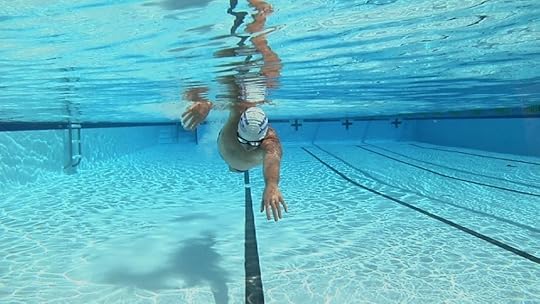
The following post was previously published by Terry Laughlin on May 10, 2010.
There’s a saying (perhaps from statisticians?): “What gets measured gets improved.” Because I aim to improve my swimming in every practice, I plan them with metrics that tell me – empirically – how I did. In most sets I use the first repeat or two to establish a “baseline,” which I try to improve upon as I go. My metrics include:
Distance of repeats and/or the set
Strokes Per Length [SPL]
Time for the repeats, and/or
Stroke Tempo (in strokes per second) from the Tempo Trainer.
In addition to the objective numbers above, I also include a subjective rating, for effort level or “mojo.” I’ll describe how I use subjective ratings in another post. Here, I’ll focus on how and why I use hard data, with examples from 3 different practices.
Last week I traveled to Pittsburgh, Thurs through Sat, to conduct a clinic for the Allegheny Mountain LMSC. While traveling, I try to swim as regularly as possible, though sometimes I can only squeeze in 30 minutes or less, as was true two of the three days I’ll recount here. As you’ll see, even 20 minutes can constitute a great practice when you aim for measurable improvement.
Thursday May 6 1000 yards at Bucknell University
While driving from New Paltz to State College, PA, I stopped in Lewisburg for a swim and lunch with Jeannie Zappe, a TI Coach. We had only 20 minutes to swim. I suggested 20 x 50 on a minute, trying to gradually increase pace, while maintaining a constant SPL.
On the first 50, swimming with consummate ease, I took 25 strokes (12 down, 13 back) and 46 seconds. My goal would be to continue taking 25 strokes per 50 for as long as possible while gradually swimming faster. This is a common set for me; I always try to let the seconds “melt away” (swim faster without trying) initially. When I succeed, it’s because my nervous system gets progressively more “tuned” to the task.
Over the first 10 x 50, I improved gradually from :46 to :42 with no perceptible increase in effort. My primary focus was to feel a longer, more slippery bodyline. When the effortless improvements no longer came, I increased effort in highly specific ways:
More sense of hold with my hand and forearm.
More snap in my 2-beat kick “toe flick” – yet keeping it streamlined within the “shadow” of my upper legs.
Over 6 x 50, I improved to 39 seconds. During my final 4 x 50 I allowed myself 1 more stroke on each length, for 27 total, and improved to 38 seconds, trying to feel a bit more ease at that higher count and faster speed. I felt great at the end.
What happened? To maintain the same SPL for an extended series of repeats, I have to travel a constant distance on each stroke. To improve pace, I have to propel myself over that distance faster. That means the frequency of my strokes also increases – though I never consciously tried to stroke faster. So Stroke Length was constant. Stroke Rate increased . . . because Velocity increased. This is different – and easier – than trying to stroke faster . . . which is the most common way to try to swim faster.
Friday May 7 4200 yards at JCC in Pittsburgh
Suzanne Atkinson brought me to the JCC where she’s a member. We swam for about 90 minutes. For warmup, I swam 400 easy, alternating 25s of FR, BK and BR. I held 13 SPL for FR, 16 for BK and 8 for BR. I can take fewer strokes on back and breast if I focus in an exacting way, but preferred to stay relaxed.
Main Set: 6 rounds of 4 x 50 + 2 x 100 + 1 x 200 with Tempo Trainer. Increase tempo by .02 sec on each round, progressing from 1.10 sec/stroke on 1st round to 1.00 sec/stroke on 6th round. I rested 10 beeps between 50s, 15 beeps between 100s, 20 beeps before the 200 and gave myself a minute between rounds to reset the TT.
My SPL on the 4 x 50 @ 1.10 was 14+15. My goal was to progress through all distances and rounds to the final 200 @ 1.00 with as little change in SPL as I could manage. I was able to keep my SPL at 16 or lower for rounds 1 through 4. In round 5 (1.02 sec/stroke) I had perhaps 3 lengths (of 24 total) at 17 SPL. In round 6 (1.00 sec/stroke), I took 17 SPL on about 6 lengths.
Suzanne and I finished with twelve 25s of Butterfly.
What happened? The goal of this set is to swim constant pace within each round — as repeat distance goes from 50 to 200 – and to improve pace with each successive round. If Tempo and SPL stay constant, so must pace. If Tempo increases and SPL stays the same (or increases very modestly), then pace improves. If SPL increases too much as Tempo increases, then pace will stay the same, or possibly even get slower.
I only checked the pace clock after the 200s. My 200 time improved an average of 2 seconds in each round. That means a tempo increase of .02 sec for one stroke created an improvement of 2 seconds (100 times as much) for 200 yards. This is a decent “trade” of tempo for speed so I ingrained good efficiency habits during this set.
Saturday May 8 2200 yards at Duquesne University
Duquesne Coach Dave Sheets opened the pool so Suzanne and I could swim prior to our clinic. He also joined us for the swim (and was impressively fast; in fact, his backstroke repeats were as fast as or faster than my crawl.)
We had only 30 minutes, so I planned a set similar to Friday’s, but with a varying pace emphasis with each round, in place of Saturday’s constant pace emphasis.
Main Set: (1 x 200 + 8 x 25) – (1 x 200 + 4 x 50) – (1 x 200 + 2 x 100) – (1 x 200 + 4 x 50) – (1 x 200 + 8 x 25) The 200s were to be swum at “Cruise” pace and the 25s, 50s and 100s at “Brisk” pace. I aimed to hold ALL repeats @ 14 SPL.
I didn’t time the 200s, focusing instead on a Stroke Thought of Superslow Recovery without sacrificing balance or stability. I swam the 25s in an average of 17 sec, the 50s in 37 sec and the 100s in 1:14-1:15.
What happened? SPL remained constant, but – as on Thursday’s 50-yd repeats – pace varied. I swam significantly faster on the 25s, 50s and 100s, than on the 200s. In this case, I did put a good deal more effort into them. But SAME SPL combined with FASTER Pace also means higher Stroke Rate. This time I accomplished faster pace by shortening repeat distance and adding a bit of effort.
Summary:
In all 3 practices I created nervous system adaptation by varying the task, while keeping at least one variable constant.
On Thurs, repeat distance and SPL stayed constant, SR (and consequently, pace) increased.
On Fri, I tried to keep SPL constant, and succeeded in minimizing change as repeat distance and tempo increased.
On Sat, I kept SPL constant while repeat distance varied. Pace and SR changed as repeat distance got shorter.
When I describe my practices, I’m often asked how I can remember so many details to record them in my log later. Part of the reason is years of “data collection and recording” have trained my brain for this kind of memory capacity (which is highly specialized; outside the pool, I’m known for being absent-minded and forgetful). But recall is also made easier by the fact that I have a context or framework for the numbers I track. I use my first repeat or two to set a baseline or benchmark– then I decide, based on experience, what sort of improvement goal I’ll pursue. Since thousands of hours of practice have improved my ability to execute what I intend, I usually need only to take note of where I’ve diverged from the plan.
Transform Your Stroke!
Learn guaranteed skill-builders with our downloadable Total Immersion Effortless Endurance Self Coaching Course! The drills and skills are illustrated in 15 short videos. Guidance on how to learn and practice each drill effectively, illustrated by clear pictures, are contained in the companion Workbook.

The post Metrics That Matter: A Model For How You Can Measure Swimming Improvement appeared first on Total Immersion.
February 7, 2020
Terry’s Practice Log: A Detailed Sample Set of Strategic Speedwork

Last week’s post described the proven principles of swimming faster, using a specific algorithm for speed– if you’re wondering what this looks like in practice, this entry from Terry Laughlin’s 2015 training log models that algorithm in a practice set. Enjoy… and Happy Laps!
This article is an adaptation of an archived TI forum post from Terry Laughlin’s training log on Nov. 5, 2015.
On Tuesday (Nov 3.) I read “The New Yorker” magazine article, WHAT WE THINK ABOUT WHEN WE RUN. In part, it was of “Poverty Creek Journal,” a collection of 51 brief reflections on a year’s worth of runs. The article also included a summary of a study published earlier this year in the International Journal of Sport and Exercise Psychology. Sports psychologists gave clip-on microphones to 10 distance runners and asked them to narrate their thought process during a run.
What did these runners think about?
How hard it was to move at their desired speed: “Come on, keep the stride going, bro.”
How soon they could stop: “Come on, you have enough energy for a mile and a half.”
And, quite often, about how miserable they felt while running.
The researchers summarized: “Pain and discomfort were never far from their thoughts.”
It made me wonder why people carry on with such a masochistic exercise. If they knew how it feels to practice Kaizen Swimming, would they give up running? Or would they run differently–the way it’s taught in ChiRunning?
In any case, the contrast between the runners in this study and the practice I’d done just one day earlier could not be more stark.
Before I describe my practice, I’ll review several principles of TI Fast Forward training methodology:
1.) Always focus on improving your swimming.
2.) Create a feedback loop– either subjective (Focal Points) or objective (Strokes Per Length/SPL, Tempo, Time). If the latter, use two metrics. Tempo+SPL or Tempo+Time or SPL+Time.
3.) To swim faster, design problem-solving exercises that strengthen your ability to hold Stroke Length, while increasing Stroke Rate. We call this the “Algorithm of Swimming Success.”
Mon 2 Nov Approx. 3500 meters at Hampton Lido, London
Sean Haywood (he was among 27 members of a TI-UK training group who went to Ironman Mallorca the previous month) invited me to swim with him at the Hampton Lido, an outdoor 36-meter pool. We swam from 6:45 to 8:00 AM. Having never swum in a 36m pool, I went in with no idea what my SPL or pace might be. But that’s never a problem. I can “create meaning” in any pool, just by counting strokes during my tune-up, which I swam in the “medium speed” lane.
Swimming with a feather-light catch and barely-there kick, I took 24 strokes the first length, then added one stroke on each of the next three laps–reaching 27 SPL on the 4th. (I later did a calculation and found that the “Green Zone” for my 6-foot height in a 36-meter pool should be between 24 and about 28 strokes.) Then the tune-up effect began to take hold, and I shaved a stroke, bringing me to 26 SPL. I swam continuously for another 10 to 12 minutes, holding 26SPL pretty steadily (except when I overtook another swimmer and sped up to pass).
Feeling ready for a challenge, I moved into the “fast” lane and turned on my Tempo Trainer. It was set to 1.17 sec/stroke. I figured that was as good a place as any to start. I swam 4 lengths (144m) continuously and averaged 27 SPL. Armed with that information, I decided to swim a Tempo Pyramid, slowing tempo by .02 each 100 until my SPL returned to 26–or 104 strokes for the 4-lap swim. I reached that at 1.23– taking 25 strokes on the 1st length, 26 strokes on the 2nd and 3rd, and 27 strokes on the 4th.
Next, I would test how long I could hold this stroke count, while increasing tempo by .01 sec after each 144m rep. With a brief exception, I held this stroke count for 11 reps–to a tempo of 1.13 sec/stroke.
I missed my intended count on only one length, taking 27 instead of 26 strokes on the 2nd lap at 1.15 tempo. Because I was a bit too slow on flip turn and pushoff, I had to rush a bit to synchronize the hand entry of my first stroke to the 4th beep. I knew in that instant that the cost of the momentary lapse would be an extra stroke. This happens commonly because while each stroke must be only .01 faster, each turn must be .05 faster (.01 x 5 beeps from final stroke on one length and first stroke on the next).
I made my approach to the wall a little stronger and somersault a little faster on the next two turns and regained my target stroke count on the final two lengths, then held it for one more rep, at 1.14. At 1.13 I exceeded my target count again and knew I’d reached my limit. I then dropped down to 3-length (98m) reps and held my 26 SPL average (25-26-27 strokes) until I reached 1.09.
At 1.08 my SPL rose again, so I cut another length from my repeats, carrying on with 2-length (72m) repeats, holding 26 SPL to 1.06. Then I cut another length and finished my practice by holding 26 strokes from 1.05 to 1.02 sec/stroke. My final length was 27 strokes at 1.01.
If a researcher had given me a waterproof mic and asked me to record my thoughts between repeats, I’d have said that I was having the time of my life. I spent over an hour focusing on every single stroke–the definition of mindfulness–and consequently remaining completely absorbed.
As I solved the challenge of holding SPL as Tempo increased, I swam almost exactly one second faster on each rep (104 strokes x .01 sec). But the experience of swimming faster was enormously pleasurable. As I progressed through the set, my movement through the water felt better and better–more integrated, more fluent. And the overall effect produced a highly satisfying Flow State. Does it get any better than that?
Take Your Swimming to the Next Level!
Learn the Habits of Mastery and develop expert-level skills with Total Immersion’s 2.0 Freestyle Mastery Complete Self-Coaching Course. Do you love learning, practicing, and swimming the TI Way? Are you excited about attaining personal mastery in the most efficient and exacting skills available in freestyle? Have you mastered the TI Foundations in prior videos or the Effortless Endurance (formerly Ultra Efficient Freestyle) Self-Coaching Course? If yes, the 2.0 Freestyle Mastery Course is for you.

The post Terry’s Practice Log: A Detailed Sample Set of Strategic Speedwork appeared first on Total Immersion.
Terry Laughlin's Blog
- Terry Laughlin's profile
- 17 followers


